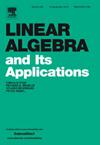On the spectra of prefix-reversal graphs
IF 1.1
3区 数学
Q1 MATHEMATICS
引用次数: 0
Abstract
In this paper, we study spectral properties of prefix-reversal graphs. These graphs are obtained by connecting two elements of via prefix reversals, where is the cyclic group of order m, is the symmetric group of degree n, and ≀ is the wreath product. If , the corresponding prefix-reversal graphs are the classic pancake and burnt pancake graphs. If , then one can consider the directed and undirected versions of these graphs. We prove that the spectrum of the undirected prefix-reversal graph contains all even integers in the interval and if , we then show that the spectrum contains all even integers in . In the directed case, we show that the spectrum of the directed prefix-reversal graph contains all integers in the interval . As a consequence, we show that in either case, the prefix-reversal graphs have a small spectral gap.
关于前缀反转图的谱
本文研究了前缀反转图的谱性质。这些图是将Cm的两个元素通过前缀反转连接起来得到的,其中Cm是m阶的循环群,Sn是n阶的对称群,而len是环积。当m=1,2时,对应的前缀反转图为经典煎饼图和烧煎饼图。如果m>;2,则可以考虑这些图的有向和无向版本。证明了无向前缀反转图Pm(n)的谱包含区间[0,2n]∈{2⌊n/2⌋}内的所有偶整数,如果m≡0(mod4),则证明了谱包含区间[0,2n]内的所有偶整数。在有向情况下,我们证明了有向前缀反转图P(m,n)的谱包含区间[0,n]∈{⌊n/2⌋}中的所有整数。结果表明,在任何一种情况下,前缀反转图都具有较小的谱隙。
本文章由计算机程序翻译,如有差异,请以英文原文为准。
求助全文
约1分钟内获得全文
求助全文
来源期刊
CiteScore
2.20
自引率
9.10%
发文量
333
审稿时长
13.8 months
期刊介绍:
Linear Algebra and its Applications publishes articles that contribute new information or new insights to matrix theory and finite dimensional linear algebra in their algebraic, arithmetic, combinatorial, geometric, or numerical aspects. It also publishes articles that give significant applications of matrix theory or linear algebra to other branches of mathematics and to other sciences. Articles that provide new information or perspectives on the historical development of matrix theory and linear algebra are also welcome. Expository articles which can serve as an introduction to a subject for workers in related areas and which bring one to the frontiers of research are encouraged. Reviews of books are published occasionally as are conference reports that provide an historical record of major meetings on matrix theory and linear algebra.

 求助内容:
求助内容: 应助结果提醒方式:
应助结果提醒方式:


